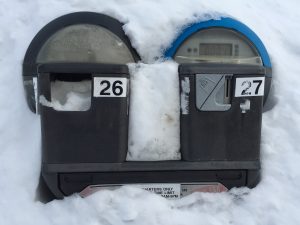- Plenty wrong with good ‘ol fashioned parking meters - May 4, 2018

“FAILURE.’
Until recently, that message was all too common on UAF parking meters, promoting confusion among users worried about tickets, as well as signaling lost revenue for the campus.
Upwards of $500 in quarters can accumulate at a time throughout UAF’s metered lots, according to office records. Collecting all those quarters takes two attendants and a lot of time. “It could take a whole shift to go through all the meters,’ Zach Wall, a political science major who’s worked for Parking Services the past two years.
The cast-iron bodies of the universities’ Meter Products parking units have been showing their age. Just how old? No one seems to know. Most in use are refurbished units.
One thing, for sure, UAF meters take a beating from temperature extremes inflicted by Fairbanks baking summer sun and subzero winter temperatures.
During winter months the reliability of meters greatly drops as the 12-volt batteries die from the cold. Replacement costs on those batteries alone runs over $300 a year, according to Parking Services records.
Ice and freezing also contribute to ongoing coin-collection problems. It’s common to find parking employees shaking or taking apart a meter during collections.
“Agh! Another coin all up in there,’Parking Service Coordinator Edward Tinajaro, exclaimed one recent Tuesday, dealing with a jam in the Whitaker Parking Lot.
“Come on,’ he said, jiggling with his knife till a bent quarter came loose.
“It is often the meters that are most used that get jammed,’ observed history major Michael McFitridge, another parking agent. “I feel like I spend half my day just with unjamming the meters.”
“Meters on crooked posts are most often problematic” he added, which points to another environmental downside to metered parking in the Far North. Parking meters here frequently suffer damage from the vehicles they police. Snow removal equipment also takes a toll.
The switch-over to the kiosk system like UAF-Luke back in 2011 has notably saved the department money because the efficiency of the system.
The Singer’s Hall and South Eielson lots were the first converted, because of their high traffic locations.
Other lots still have meters, notably Wood Center and Whitaker, which attract UAF’s second-highest traffic volume.
Kiosks, which print out receipts meant to be displayed on the user’s dashboard, are found in student-decal lots, and those shared by visitors or part-time students. An app is available for sections identified by signage.
“It’s great. I can pay off with my smartphone!’ said Holly Billings, of Fairbanks, who uses the Patty Center parking lot to pick up her kids from swimming practice. “The app lets me know when I am running out of time, and I don’t have to root around for quarters!’
Most full-time students purchase a decal for the semester or a full year. “It’s just apart of the costs of school, like tuition!’ said computer science major Hal DiMarchi.
With fines set at $15 expired parking in most campus lots, the switch-over to paying by kiosk or smartphone app- Passport Parking, is intended as a convenience.
There are critics.
“Everything is becoming much more complicated!’ said an older man, who declined to give his name. “There is nothing wrong with a good ol’ fashion meter!’
Not all lots will be getting meters in the near future, according to Tinajero.”It doesn’t make sense for some of the lots to be Pay by Plate, and upper campus would be too hard to implement
Kristopher Voronin is a second-year elementary education and a minor of digital journalism who works at Parking Services.
